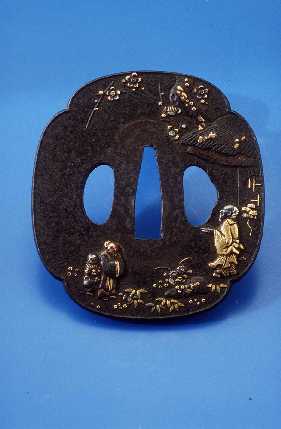 NEW! Mystery object identification needs your input. Click here for Asian mystery object... thanks! gavin
NEW! Mystery object identification needs your input. Click here for Asian mystery object... thanks! gavin
Gavin Hougham's Japanese and Chinese art


Tsuba, Japan
Iron, mokko form, with decorative alloys in gold,
silver, copper (or shibuichi), and small amounts of shakudou.
7.6 cm x 7 cm x 0.4 cm.
Decorated with a Chinese-style scene on the front surface in raised (takabori?) style of a scholar or literati taking a break from his work. He stands outside a small thatched building and with his raised hand palm down, beckons his teacher and a small boy bringing tea. His gold robe suggests royalty. The group will admire the spring cherry blossoms and bamboo together (ohanami). On the reverse is a quiet scene of a brook passing through rocks in the garden. The reverse side also has two flaws in the rim area whose position and angles suggest they are old "cut" marks from an opponent's sword blow.
Tsuba with Chinese themes became especially popular during the relatively peaceful Tokugawa or Edo period. The piece is unsigned but suggests the work of Someya Tomonobu (late Edo), Kuritomo Sadahide at Kaneyama, Mito school, and the influence of the earlier Kanieye or Jakushi school work. A tantalizing but wholly speculative possibility (following Paula Stewart) is that the scene loosely depicts sinophile Ieyasu Tokugawa's own grandson, who was a brilliant scholar and historian who wrote the Dai Nihon Shi (History of Japan) in 1715.
Your comments and kantei information about this tsuba welcome
Single-pronged Kongo Vajra. Kamakura Period, 13th Century
(Shoshuraigo-ji Temple/Kyoto National Museum)
© 2001  Mail to: ghougham@yahoo.com
Mail to: ghougham@yahoo.com
HERE is a list of places to visit in Japan and the U.S. to see excellent displays of nihonto, kodogu, armor and associated artifacts. The list is a compilation of suggestions made by myself and fellow travellers. Additions welcome!
